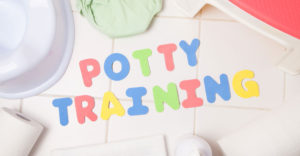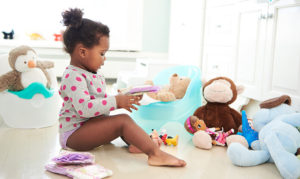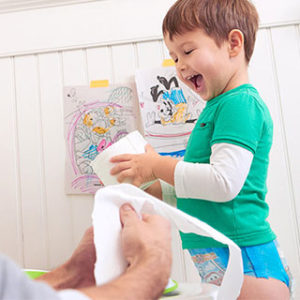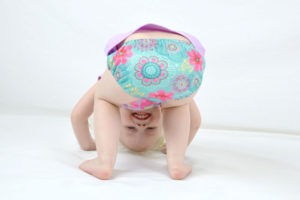
Although we are potty trained in our household with two of our three girls, I feel like it is one of those topics every mommy and daddy struggles with. Potty training either goes SLOWLY or your child just “gets it” and is trained in no time. Having trained two little ones (one with ease and one that took some time), I feel I have some tips and tricks that can ease the troubles when learning to go to the restroom at the right time and place.
Potty training involves putting together a set of individual skills in a certain order, such as being able to interpret the signals your body is giving you, undressing, having some control over your bowels and bladder, and washing your hands. Your child should have at least some of these skills mastered before starting potty training, or you’ll both become frustrated.
Here are three steps that can help your child maximize his success.
1. Preparation
- Get a potty chair. Many children feel more secure starting with one that sits on the floor rather than one that sits on top of the toilet. It’s less scary, and it gives them the security and balance that comes with being able to put their feet securely on the floor.
- Put the potty chair in a place that’s convenient to where your child spends most of his time. It doesn’t have to be in the bathroom; we always kept it in a corner of our playroom. Ease of access is important in the beginning.
- Let your child explore the potty chair and become familiar with it. Let him know that it’s special and it’s just for him. I usually just have the potty chair out and visible for a good month before introducing potty training.

2. Learning.
Have your child practice sitting on the potty with her clothes on once or twice a day. Let her get up whenever she wants. Your goal is to help her become comfortable with it.Praise them for each step, even the small ones and the ones that aren’t completely successful. Stay upbeat. Remember that this is his/her accomplishment, not yours. Once she’s comfortable sitting on the potty with her clothes on, have her practice sitting on it with her clothes off. This helps her get familiar with the concept of removing her clothes before going to the bathroom. It also lets her feel what the seat is like next to her skin. Let your child see you sitting on the toilet. Let her sit on her potty chair at the same time, if it’s in the bathroom. It’s easier for boys if they first learn to use the restroom while sitting down. If they begin by standing up, sometimes they’ll resist sitting down to have a bowel movement; it’s too confusing.

3. Reinforcement
- Give your child lots of praise at each stage of learning. It’s also a good idea to praise him whenever he tells you he has to use the potty, even if you’ve just asked him the question. I have done everything from a sticker chart to a bowl full of Skittles. With the sticker chart, once they go 5 times (adjust this to meet your child’s needs), they can pick something out of a prize box. I wrap everything in the prize box so they don’t know what they are opening and they get the thrill of opening presents. With the Skittles, I give them 1 Skittle (yes just one-they are happy with just one) after they go #2. It gives them incentive to try since that seemed to be difficult for both of my girls.
- Expect him to make mistakes, especially in the beginning. Don’t get angry; that will just make things take longer. If he resists trying something new, it probably means he’s not ready yet. Simply back off and try again in a few days or even weeks.
- Once your child has been successful for a few days, start making the switch to underwear. Some children feel more secure in diapers or training pants; others can’t wait for “big boy” or “big girl” underwear. Let your child’s reaction guide you in how quickly you make the change. In our household, once we were dry throughout the day for 2 days straight, I let them go to the store and pick out their own underwear. This makes them excited to keep continuing with the process.
- Remember that some young children are frightened by the sound and actions of a flushing toilet. If he’s bothered by it, don’t force him to flush; do it after he leaves the room. That fear usually goes away in a few months.

There you have it. Potty training doesn’t have to be difficult as long as you have some tips and tricks up your sleeve to help you on your way. As long as you keep the frustration at bay and know that over time, your child will be potty trained, your making the first step to being successful. Good luck and drop a comment below letting me know some of your tips and tricks that have been successful for you.




0 Comments